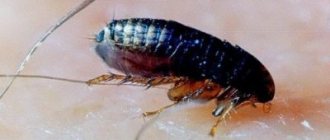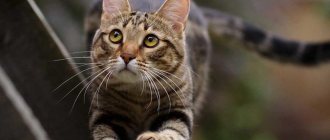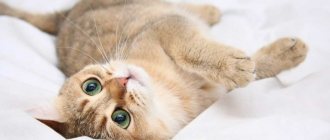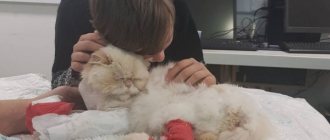Cats are the most beloved of all living creatures domesticated by people. An example of this is the story of Kate Birdsall Johnson (USA): this lady had true love for them; about 350 of them lived in her house in California! Commissioned by this American woman, the world's largest painting depicting cats was painted: the canvas measuring 2.58 m by 1.78 m featured 42 of the owner's pets. The name of the picture was given by the husband Keith Johnson, implying the passion that his wife had for these animals.
The subject of this article is the physiology and psychology of the “intimate life” of cats themselves. At what age does “this” first happen to them? What are the signs of the beginning of the “walking” process? Does this process vary depending on the breed? – these and other issues will be considered.
Karl Kahler "My Wife's Lovers" The painting was completed in 1891 and took the artist three years to complete.
When asked about the specific age at which cats begin to walk, it is not always possible to give a definite answer. They typically reach sexual maturity at 7-9 months of age, although in some breeds this occurs earlier. Thus, the “cat horoscope” can play a role: “winter” cats, already at the end of the first spring or summer in their lives, can experience the call of nature. “Early” cats are considered to be representatives of their eastern type - Siamese, Sphynx, Thai. In general, “gracefully” built male cats are more prone to early puberty.
"Cat" yin-yang
Stages of Puberty
The age of onset of puberty is also influenced by the animal’s habitat: for example, keeping in a nursery can awaken in still young cats and female cats the desire to “continue their kind” under the influence of pheromones emanating from their sexually mature neighbors in the nursery. Street animals, which do not always eat well, “grow up” in this sense later than domestic animals, which are fed in abundance.
However, despite the above nuances, the recommendation of experts for the age of first mating is universal: for both females and males, the first mating is recommended no earlier than their first birthday. Earlier mating and pregnancy can lead to deflection of the spine, difficult birth, and sometimes death of the cat and kittens. In addition, the fetus may stop in its development, and in cats that are too young, due to sexual exhaustion, the overall period of their fertility may be shortened.
Cats mature earlier than males - at 5-6 months of age. What time do loving cats start hanging out with cats? As a rule, at 8-10 months.
The stages of cat puberty are:
- precursor (proestrus), lasts, as a rule, 1-2 days, is characterized by the appearance of anxiety;
- estrus (estrus), lasts from 4 to days, the cat meows loudly at this time, calling for a male, stretches out its tail and bends its hind legs;
- post-estrus (meteestrus), its period of 1-2 weeks is a period of decreased sexual desire, the cat can show aggression towards cats (if fertilization occurred during mating);
- anestrus – the final stage, the animal returns to normal behavior and condition;
- rest (break between heats), lasting 1-3 months.
Stages of estrus in cats
Estrus is divided into 4 phases. Even an experienced owner will find it difficult to distinguish one period of estrus from another. However, knowing the physiological characteristics of the mustachioed tabby, it will be possible to calculate a favorable date for mating, as well as avoid unpleasant incidents.
- Proestrus. This is the preparatory phase. It lasts from 1 to 4 days. You may notice changes in your cat's behavior. The pet rolls around on the floor, caresses its owner, and the first scanty discharge appears. At this stage, the female will not allow the cat to approach her, since she is not yet ready for fertilization.
- Estrus. The second stage is called the same as the entire cycle. The estrus itself lasts from 5 to 10 days, which largely depends on the breed. Under the increasing influence of hormones, it is already difficult for the cat to control its behavior - it screams day and night, and when stroked it takes a position characteristic of mating. Transparent discharge becomes noticeable. Planned mating or spontaneous mating occurs precisely during this phase.
- Interestrus, metestrus or post-estrus. The third period can take place according to several scenarios, depending on how the previous stage ended. If the cat had mating, during which fertilization occurred, then pregnancy occurs during metestrus, and after 60-70 days kittens will be born. There are cases when conception does not occur during sexual contact, and the pet develops a false pregnancy. This condition resembles a normal pregnancy in its symptoms, but does not end with childbirth and goes away after 30-45 days. If the cat has not had contact with a male, then over the next 2-15 days the attraction fades, interest in the opposite sex gives way to aggression.
- Anestrus. The final phase is called the rest period. The pet behaves in its usual way. The duration of anestrus can range from 3 weeks to several months. A cat that has given birth will have a longer period of calm than a cat that has not found a mate.
Estrus as a physiological process
An unambiguous sign of an animal’s puberty is the appearance of estrus (scientific name – estrus) in a cat’s life, which occurs as a result of repeated changes in its internal genital organs.
The intervals between estrus vary and depend on the time of year, as well as the breed of the animal. Spring and autumn, as periods of estrus, are characteristic of old, wild and stray animals.
If during this period the cat is not fertilized by the cat, the eggs will not be released, the swollen mucous membrane will gradually return to normal and will prepare for the next heat.
Invisible or muted signs of estrus are a symptom that the cat is overfed or painfully weakened.
It is also worth knowing: females can mate only during the period of heat, and males are ready to cover cats at any time. The “March” habits of cats are well known; March is the most active period for them, due to the increased concentration of sperm.
I'm always ready! And not only in March...
A sterilized cat is in heat
Many mustachioed tabby owners are thinking about spaying or neutering their cat. Many myths and discrepancies have arisen around these operations. Even to such a key question: “Will the cat go into heat after sterilization?” – you can see different answers. Let's figure it out.
When talking about operations to prevent reproduction, they include castration and sterilization. During sterilization, the cat's fallopian tubes are ligated, and the cat's seminal ducts are ligated. The animal will not be able to become a parent, but the production of hormones and sexual instincts are preserved. Thus, spayed cats remain in heat. During castration, the gonads, and sometimes the uterus, are removed. Accordingly, a castrated cat will not be in heat, and the cat will not mark its territory and go on sexual hunts. To simplify, castration of a cat is often called sterilization, however, when signing up for an operation at a veterinary clinic, you need to understand what effect you want to get from the procedure.
Modern clinics offer operations with laparoscopic access. Instead of incisions, small punctures are made on the cat’s belly, so sterilization is gentle and the pet recovers quickly.
There are 3 main types of operations, the first of which is essentially sterilization, and the other two are castration.
- Tubal occlusion. The cat's fallopian tubes are tied, as a result of which she will not be able to become pregnant. This method is rarely used today, since regular estrus with all the ensuing consequences persists, and there is a risk of inflammation of the uterus.
- Ovariectomy. During surgery, the cat's ovaries are removed. Estrus stops, plus the pet will no longer have polycystic disease or tumors in the mammary glands. At the same time, the uterus remains unchanged; this organ is not immune from diseases.
- Ovariohysterectomy. This operation completely prevents inflammatory processes in the cat’s reproductive organs and involves the simultaneous removal of the ovaries and uterus. As in the previous case, there will be no heat.
Duration of estrus
They usually “walk” for a week, plus or minus 2 days, this has an individual character. The duration of estrus in cats is often hereditary.
How to relieve symptoms of estrus
The use of special medications from the arsenal of cat therapy during each estrus - “Contrasex”, “Sex-barrier”, “Stop-intim”, etc., will inevitably lead the cat to hormonal imbalance. The ovaries will develop dysfunction and pus (pyometra) or hematopyometra - pus with blood - may appear in the uterus. Sterilization will help avoid such complications in your cat.
Sterilization
If the owner of the cat is not interested in breeding the breed, then it is best to perform castration or sterilization. During sterilization, the genitals of animals remain, but their functions are disrupted through surgery.
In cats, castration is most often practiced - this is the surgical removal of the genitals (eggs). It is best to castrate cats after six months.
Removing the ovaries will help reduce the risk of cancer and prevent pregnancy. Sterilizing a cat is a more complex process than castration: it is a complex abdominal operation to remove the ovaries. Cats can be sterilized at any age. Rarely, after this operation, she may go into heat (due to residual ovarian tissue), only a veterinarian can help in this situation.
The timing of sterilization is very important and is determined by the veterinarian; due to the risk of large blood loss during estrus, this operation is not performed. It is best to allow the cat's reproductive system to develop and sterilize it after the first heat (in the stage between heats).
Through castration, the animal becomes cleaner, more affectionate and calmer. Despite the painfulness of the procedure, mental depression does not occur. It takes about a week after the operation for the animal to forget about its previous desires, and then it can simply sleep peacefully next to “its beloved half”….
Good night, darling. Good dreams, dear...
Hormonal drugs
Hormonal drugs prostaglandin and estrogen stop estrus. Hormone therapy is used when other methods to stop estrus have not helped. However, hormonal therapy for cats is fraught with the appearance of tumors and uterine infections.
Overweight cats have low hormonal levels.
What to do
For the owner, there are the following ways to solve the problem of estrus in a pet:
- Sterilize to protect against pregnancy forever. In this case, there is a risk of hormonal imbalance and suppuration of the sutures.
- Use contraceptives. They will dull arousal, but there is a danger of harm to health from taking hormonal drugs.
- Connect with a male. After the birth of kittens, the cat will become calmer and will walk less.
- Distract from sensations during heat. Buy new toys, pay more attention.
If the owner is in doubt about what to do with the pet, it is worth contacting a veterinarian for advice. This will help avoid new health problems.
Frequency of cat walking
Each cat has its own cycle of “binging”: some - once every two to three months, others - once a year, very rarely - once every one and a half years. They usually “walk” for a week, plus or minus 2 days, this has an individual character. The system of estrus in cats is often hereditary.
Pedigree cats that live with a person, and therefore depend on him, may have many more estrus cycles with an interval of approximately 15-25 days.
How long does it take to walk for the first time?
The first “walking” process in a young cat’s life usually lasts 3-7 days.
Frequency depending on breed
"Getting to know" Siamese cats. (note to owners: Siamese cats have a slightly shorter pregnancy than other breeds)
If we talk about the time of onset of heat, then the St. Petersburg Sphynx, as well as cats of the Siamese, Thai, Oriental and Burmese breeds begin to “walk” earlier than representatives of other breeds. In the Scottish Fold and British Shorthair, estrus occurs less frequently than in the Persian and Siamese breeds.
How long does a cat's heat last?
Each cat goes into heat differently; a period of 5 to 20 days is considered normal.
Estrus that is too short or absent may be associated with pathologies of the thyroid gland and underdevelopment of the ovaries. If the heat, on the contrary, is prolonged, this may be a symptom of inflammation of the ovaries, as well as cysts and tumors. Important: It is recommended to sterilize your cat if you do not plan to breed. With a large number of estrus without fertilization, the likelihood of developing diseases of the reproductive system increases, and hormonal drugs that suppress estrus have serious side effects. Sterilized cats do not annoy the owner with inviting meows, do not run away in search of a cat, and live several years longer than pets that have not undergone surgery.
Features of mating
Ready for a date!
Cats have a closed character, and the process of fertilization is not easy for them. So, cats tend to force the male to beg himself for a long time, to run away from him, therefore, for mating, it is customary to carry the cat to the cat, and not vice versa. In addition, with such an organization of the “process”, the cat feels like a master in its territory.
Accepted, but I'll think about it some more...
Preparation for successful mating (ending with fertilization) should begin with keeping the cat with the cat for two to three days. When mating for the first time, it is better for one of the partners to be “more experienced.” When covering a cat, the male grabs the fur on the back of the cat's neck with his teeth and performs a process that usually lasts about five seconds. The signal for the end, as a rule, is a shrill cry from the female, at the same time the male jumps to the side, and she begins to ride on her back. One cat is capable of covering a cat about ten times in one hour. If several cats bred the same cat, then multiple fertilization may occur, and then each kitten may have its own father in the litter. The owner's actions during mating concern mainly the cat - the cat can be stimulated by stroking and scratching the head. Scratching under the chin, the owner holds it until the cat takes the cat by the scruff of the neck. A breeding cat can breed no more than two cats per month (one female once every two weeks).
This is a very intimate moment. There's no place for strangers here
Continuation of the cat family (features of pregnancy in cats)
The first signs of pregnancy, which lasts 9 weeks in a cat (usually from 55 to 66 days), are determined 2-3 weeks after mating by the color of the nipples - they turn pink and swell slightly. It should be noted that pregnancy in adult cats (from 3 years old) does not always have such symptoms.
There are rare cases of false pregnancy in cats, accompanied by all the signs of a normal pregnancy, but the embryo does not develop: the cat gets fat, gains weight, prepares a place for the cubs, and milk may appear. The causes of false pregnancy are purely physiological and should not be considered a pathology.
Miscarriages also occur in cats (most often at 4-5 weeks of pregnancy), which are the result of rough treatment of the animal or the presence of a uterine infection. Feline abortions have not yet been practiced anywhere.
About the average age of cat maturation
For the first time, the physiological need for male attention arises at 6-9 months, but in many long-haired and large breeds, such as the Maine Coon, this process drags on for up to a year. And vice versa, short-haired and outbred animals born in the fall can begin to walk by spring; this is inherent in their nature.
Cats can carry, give birth and raise viable offspring without complications only at actual maturity. Therefore, you should not start mating with a cat before 1-1.5 years of age, as this can cause serious health problems.
Expert advice
The owner’s desire to nourish his pet with vitamins for the normal course of physiological processes must be accompanied by the knowledge that there are products for cats (for example, “Irish Cal”). Medicines aimed at people are not suitable for them.
To stimulate estrus (if it does not occur in the cat), vitamin E is prescribed, as well as the products “Katozal”, “Ovariovit”, “Ovarium”, “Compositum”, “Ortilin”, “Gamovit”. For the same purpose, the cat can be placed in the same space with a neutered cat or with a cat who is in heat.
Vitamins can help us...
When does a cat start asking for a cat?
Many owners are interested in the question of what time cats start walking and how long this period lasts. Naturally, all animals are individual and each one experiences this moment at a different time. As a rule, the furry creature begins to ask the cat at about 6 months. But no later than 10 months.
There are a number of factors that influence what time a cat starts begging:
- breed;
- feeding characteristics and food quality;
- conditions of detention.
Representatives of the cat family reach sexual maturity at 7-9 months. True, in some breeds this happens earlier. During puberty, the pet acquires the ability to produce mature eggs. But this does not mean that from the first heat the animal is ready to conceive. It is necessary for the animal to grow a little more and get stronger.
If not hormones, then what?
Since hormonal drugs can be harmful, it is better to use more gentle options. For example, “Fitex” or “Cat Bayun”. These are herbal-based preparations, therefore they are the safest for cat health. “Palladium”, “Bromine” and “Ignacia” have also proven themselves well. These are homeopathic remedies that have a gentle effect on the body and do not cause side effects. In addition, the result is achieved almost immediately after use.
Many veterinarians advise sterilization if the owner does not want the cat to give birth to kittens. After the operation, the pet will no longer walk and will not be able to get pregnant. The pills temporarily suppress her arousal. And besides, they can cause irreparable harm to health. It makes sense to use such drugs if mating is not planned now, but in the future the owner plans to breed a cat with a cat. What exactly to choose, sterilization or taking sedative hormonal medications, it all depends on the decision of the pet owner, as well as the health and age of the animal. Read more about the use of sedatives here.
This article discussed how to understand that a cat wants a cat, when it is recommended to breed and how to do it correctly. Each cat has its own character and preferences. And it is important to learn to understand your pet. If the owner does not want the cat to give birth, it is better to undergo sterilization surgery. Of course, you can use various drugs to suppress your pet’s sexual arousal, but many of them, especially hormonal ones, can be harmful to health.
Signs of a spree
Don't be afraid to miss the time when your cat is walking, you will definitely notice it by her behavior. The most intense period of estrus occurs in animals from February to April. In the fall, the pet asks the cat less expressly.
The signs of binge drinking are as follows.
- Decreased appetite. The cat refuses its usual food and does not even pay attention to treats. The owner needs to carefully monitor the behavior, since a decrease in appetite may be a sign of an emerging disease.
- Loud scream and piercing meow. The animal's voice is not quite usual. The cat calls the cat in this way.
- Tags all over the house. Cats mark their territory during heat. According to one version, the animal does this involuntarily. On the other hand, it marks the boundaries so that no one penetrates into the occupied territory. However, it is also believed that the pet attracts the male in this way.
- Overly affectionate or aggressive behavior. The animal rubs against the owner’s legs, purrs, tries to get under the arm or reacts inappropriately to the owner, scratches and bites.
- Frequent urination. During estrus, physiological changes occur in the body, causing frequent urination.
- Adopting mating positions. The cat shows the male that she is ready for mating by lowering herself on her front legs and raising her hindquarters.
Based on the listed signs, the owner will accurately determine that a spree has begun.
When to think about mating
Most owners of four-legged cats do not know when to breed a British cat. People are afraid of making mistakes, so they delay the process.
Characteristic signs of a cat are:
- Loud and constant shouting. This is how the pet tries to call the cat to her.
- Constantly rolling on the floor and licking your genitals.
- A sharp change in mood - the animal can either be too affectionate, or, on the contrary, show unreasonable aggression.
- While stroking, the pet arches and raises its tail. In this way she shows that she is ready to meet the cat.
For a cat, things are a little different:
- Animals begin to actively mark all corners in the house. Attempts to scold the cat do not lead to anything good; he tries even more actively to show what he needs.
- The cat rubs against sharp objects or those that interest him. Often people observe some kind of friction, body movements are directed towards the thing that the pet is interested in.
- Pets change dramatically. Some people do not recognize cats as their four-legged companions.
Important! There is no need to try to calm or scold the animals at this moment. Instincts that are higher than everything “awaken” in them.
If the pet is already ready, then it can happen to someone; if offspring are not included in the plans of the owners, then it is more humane to perform sterilization so as not to torture either yourself or the pet.
What can I do to stop my cat from wandering?
Some owners do not plan to breed their pet and, so that it does not disturb the calm atmosphere in the house, use special preparations. Today, there are various pills for cats against walking that regulate the processes of sexual arousal, prevent unwanted pregnancy, calm the animal and make behavior normal.
But opinions differ regarding the safety of using such drugs. Some people believe that it is necessary to use anti-festival pills if mating is not planned. Others are confident that hormonal pills or drops for cats during estrus are harmful to the health of the pet. If, nevertheless, the owner is going to give drugs for estrus, only an experienced veterinarian should prescribe the drug.
Properly selected, suitable drops or tablets will gently normalize hormonal levels and will not harm the animal.
Manufacturers offer many drugs to solve problems with increased sexual activity in cats. For example, Gestrenol tablets are quite effective and gentle on the body. The product contains analogues of natural hormones. In addition, with o, the reproductive function is restored after a couple of months.
Among the effective contraceptives one can also name “Anti-sex”, “Contra-sex” and “Sex barrier”. But these drugs are hormonal. To quickly calm a cat, Covinan injections are used. The reasonable price of Covinan for cats makes this drug quite popular among owners of representatives of the cat family. But it is worth remembering that this drug, like any other hormonal drug, has contraindications. For example, it is not recommended for young individuals and those over 5 years of age to use Covinan injections.











